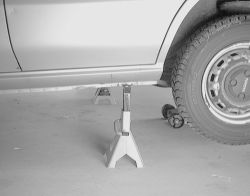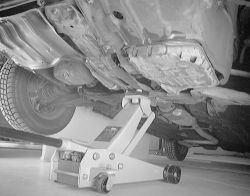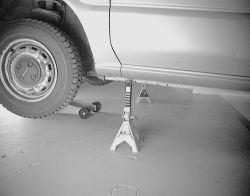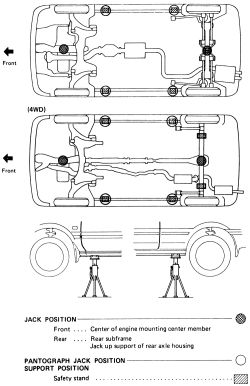
See Figure 1, 2, 3, 4 and 5
Your vehicle was supplied with a jack for emergency road repairs. This jack is fine for changing a flat tire or other short term procedures not requiring you to go beneath the vehicle. If it is used in an emergency situation, carefully follow the instructions provided either with the jack or in your owner's manual. Do not attempt to use the jack on any portions of the vehicle other than specified by the vehicle manufacturer. Always block the diagonally opposite wheel when using a jack.
A more convenient way of jacking is the use of a garage or floor jack. You may use the floor jack to raise the vehicle and place stands on the jacking points under the vehicle.

 |  |
Fig. Fig. 1: Jacking point on the rear of the vehcile using a hydraulic jack

 |  |
Fig. Fig. 2: Always use saftey stands to support the vehicle
Never place the jack under the radiator, engine or transmission components. Severe and expensive damage will result when the jack is raised. Additionally, never jack under the floorpan or bodywork; the metal will deform.

 |  |
Fig. Fig. 3: Place the hydraulic jack under the crossmember raise the front of the vehicle

 |  |
Fig. Fig. 4: Place the saftey stands on both sides of the car
Whenever you plan to work under the vehicle, you must support it on jackstands or ramps. Never use cinder blocks or stacks of wood to support the vehicle, even if you're only going to be under it for a few minutes. Never crawl under the vehicle when it is supported only by the tire-changing jack or other floor jack.

 |  |
Fig. Fig. 5: Vehicle lift and support locations-2WD and 4WD models
Always position a block of wood or small rubber pad on top of the jack or jackstand to protect the lifting point's finish when lifting or supporting the vehicle.
Small hydraulic, screw, or scissors jacks are satisfactory for raising the vehicle. Drive-on trestles or ramps are also a handy and safe way to both raise and support the vehicle. Be careful though, some ramps may be too steep to drive your vehicle onto without scraping the front bottom panels. Never support the vehicle on any suspension member (unless specifically instructed to do so by a repair guide) or by an underbody panel.